15 Health Benefits of Gomukhasana & How to Do It?
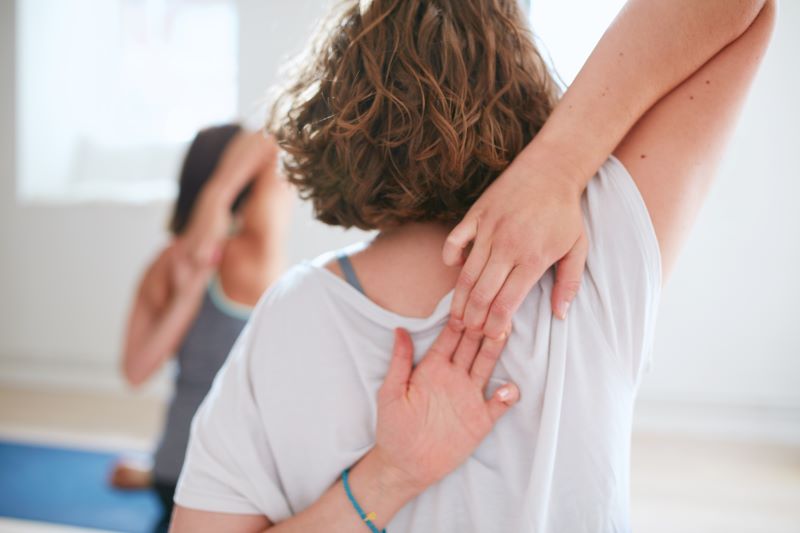
A good way to improve body posture is by practising yoga. Gomukhasana is one such posture which stretches the muscles in the chest, knees, ankles and shoulders and helps improve overall body structure. Curious to know more about the benefits of Gomukhasana, then keep scrolling!
Gomukhasana, or cow face pose, is a renowned yoga posture revered for its multifaceted health advantages. Now, let's delve into the 15 benefits of Gomukhasana and learn how to perform it correctly.

Table of Contents

What is Gomukhasana?
Gomukhasana is commonly known as cow-face posture because the body resembles a cow's face when one forms this position. It is a seated yoga position that aids chest, triceps, shoulders, and arm stretches. In addition, this pose is soothing and helps reduce tension in the hips and shoulders.
It is also the most dependable and efficient way of holistically nourishing and toning the body.
How to Perform Gomukhasana?
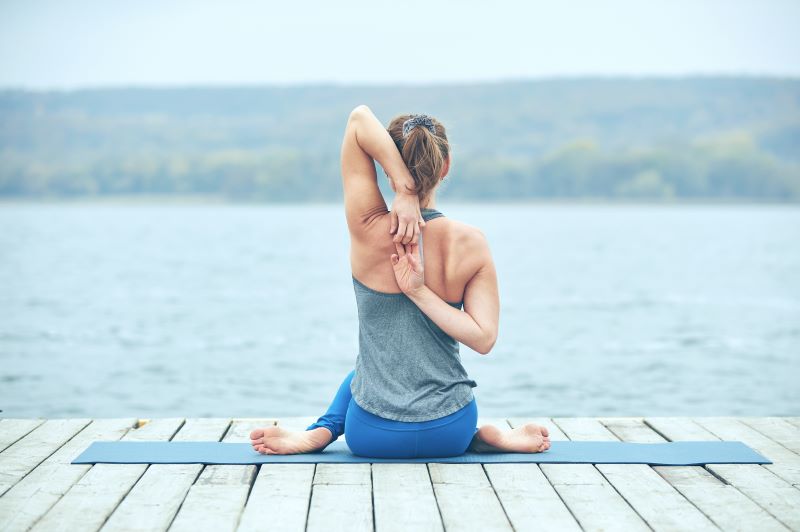
The following are the steps one needs to follow to perform Gomukhasana.
Step 1: First, take a seat on the mat with your back straight and legs extended in front of you.
Step 2: Bend your left knee and place your palms on the ground. Raise your body a little and put your left foot below your right hip.
Step 3: The right leg should be folded and placed over the left thigh. Then put your left arm in a folded position behind your back.
Step 4: Stretch your right arm as far as possible until it reaches your left hand by gently crossing it over your right shoulder.
Step 5: At first, you might not be able to join your hands, but with practice, you will be able to.
Step 6: Lean slightly back, open up your chest, and keep your body upright.
Step 7: For a few breaths, maintain this posture. Keep your breathing in mind as you gently return to the starting position.
It is suggested that you hold the position for 30 to 60 seconds while continuously breathing. Then, you can gradually extend the time as you excel.
15 Health Benefits of Gomukhasana
Gomukhasana offers numerous health benefits to practitioners. From flexibility to relaxation, it impacts physical and mental well-being positively. The following are the health benefits one can derive by performing this asana.
1. Enhances Posture
Gomukhasana stretches the muscles in the ankles, knees, chest, and shoulders, strengthening them while also enhancing your posture. Nearly all of the body's joints move while performing the asana, which improves blood flow and guarantees the body receives adequate amounts of blood and nutrition. Over time, it helps to avoid injuries to the shoulders, back, chest, and ankles, thereby also improving posture.
2. Cure for Sciatica
Another advantage of Gomukhasana is that it can either alleviate or prevent sciatica pain by lengthening and stretching the spine.
3. Improves Kidney Function
One of the best asanas for supporting the kidney's efficient operation is Gomukhasana. It lessens the development of kidney stones. Additionally, it promotes frequent urination, which helps to wash out all toxins, acids, and other undesirable substances.
4. Reduces Stress and Anxiety
Juggling work and personal obligations is a hard part of everyone's life. One of the best poses for de-stressing is Gomukhasana. The ideal mix of physical and mental exercise reduces blood pressure and heart rate, the two main signs of stress.
5. Enhances Sexual Performance
Many yoga teachers advise performing Gomukhasana frequently to maintain a healthy sexual life. This pose tightens our genital organs, which helps them produce sex hormones, boosts blood flow, etc. Additionally, it tones the thighs, calves, and hips, which is vital for sexual performance.
6. Improves Cardiovascular Health
Numerous studies have demonstrated that regular practice of Gomukhasana can enhance cardiovascular health and aid in the prevention of various cardiovascular diseases, including heart attack, stroke, high cholesterol, and others. This is because Gomukhasana helps to open the chest muscles, which enhances blood circulation and lessens the strain on the blood vessels, preventing the buildup of fat and cholesterol in our bodies.
7. Helps to Reduce Diabetes
Practising Gomukhasana daily can enhance the body's ability to produce insulin, which helps to reduce blood sugar absorption, the leading cause of diabetes. Therefore, practising this asana for persons dealing with diabetes is highly beneficial.
8. Improves Flexibility
Gomukhasana stretches the shoulders, chest, and hips, enhancing flexibility and range of motion in these areas. This can be particularly beneficial for individuals with tight hips and shoulders due to prolonged sitting or repetitive activities.
9. Strengthens the Spine
Gomukhasana requires maintaining an upright posture, which engages and strengthens the muscles along the spine. This improved muscular support enhances spinal health and stability, potentially reducing the risk of back pain and improving overall posture and alignment.
10. Enhances Lung Capacity
By opening up the chest, Gomukhasana enhances lung capacity. This allows for deeper, more effective breathing, which can improve oxygen intake, boost overall respiratory health, and increase energy levels.
11. Boosts Circulation
Stretching the arms and legs in Gomukhasana improves blood circulation to these areas. Enhanced circulation ensures better oxygen and nutrient delivery to tissues, promoting overall cardiovascular health and aiding in the removal of metabolic waste.
12. Helps with Carpal Tunnel Syndrome
The arm position in Gomukhasana provides a deep stretch to the wrists and forearms, alleviating tension and improving flexibility. This can help reduce symptoms of carpal tunnel syndrome by relieving pressure on the median nerve.
13. Balances Energy
Gomukhasana is believed to activate the Anahata (Heart) Chakra, which is associated with love and compassion. Balancing this energy centre promotes emotional well-being and harmony, enhancing one's overall sense of balance and inner peace.
14. Enhances Focus and Concentration
Maintaining Gomukhasana requires concentration and balance, fostering mental focus and clarity. This practice of mindfulness can enhance cognitive function, improve attention span, and support better mental health by reducing stress and anxiety.
15. Improves Joint Health
Regular practice of Gomukhasana helps lubricate the joints by promoting synovial fluid production. This reduces stiffness, enhances joint flexibility, and supports overall joint health, making movements smoother and less painful.
The Mudras of Gomukhasana
Mudras, or hand gestures, are an integral part of yoga that channel energy flow and enhance the benefits of various poses. In Gomukhasana specific mudras can be incorporated to deepen the practice, promoting physical, mental, and spiritual well-being.
1. Anjali Mudra (Prayer Gesture)
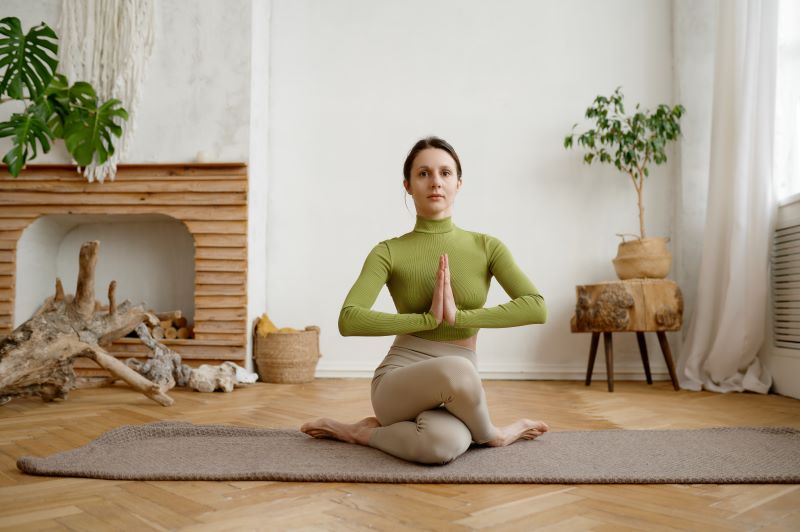
Anjali Mudra involves pressing the palms together at the heart centre. In Gomukhasana, this mudra helps to centre the mind and balance energy, promoting a sense of inner peace and unity.
Benefits of Anjali Mudra: Anjali Mudra fosters a sense of gratitude and humility. It helps centre the mind, encourages a meditative state, and promotes harmony and balance within oneself, enhancing the spiritual aspect of the practice.
2. Gyan Mudra (Gesture of Knowledge)
Gyan Mudra is formed by touching the tip of the thumb to the tip of the index finger, with the other fingers extended. Practising this mudra in Gomukhasana can enhance concentration and wisdom.
Benefits of Gyan Mudra: Jnana Mudra helps improve concentration and focus by channelling energy to the brain. This mudra promotes mental calmness and reduces stress and anxiety. This mudra helps boost memory and cognitive abilities.
3. Garuda Mudra (Eagle Gesture)
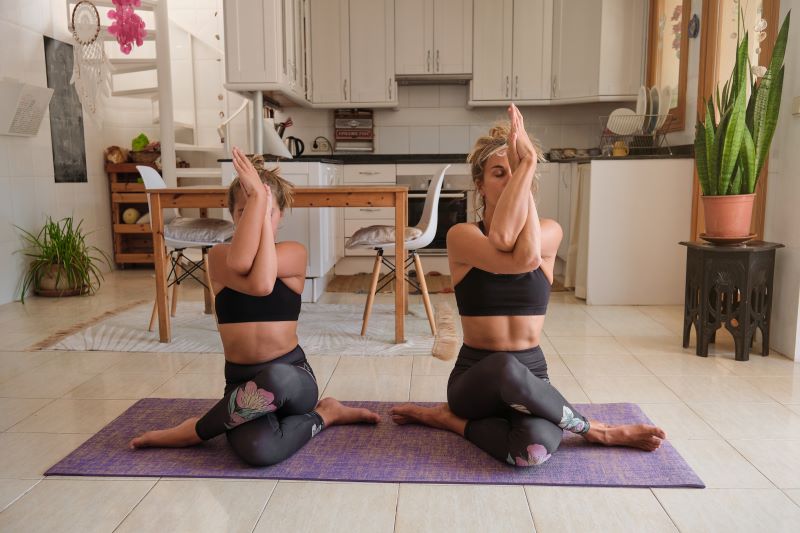
Garuda Mudra involves intertwining the hands like an eagle pose. In Gomukhasana, placing the hands in this mudra while in a seated position can boost circulation and energy flow.
Benefits of Garuda Mudra: Garuda Mudra enhances blood flow and energises the body, helping to reduce fatigue and invigorate the system. This mudra helps balance hormones and alleviate stress, promoting emotional stability and a sense of calm.
Types of Gomukhasana
Gomukhasana, a fundamental yoga pose, has several variations that cater to different levels of flexibility and focus on various aspects of the body. Here are some notable types:
1. Seated Forward Bend Gomukhasana
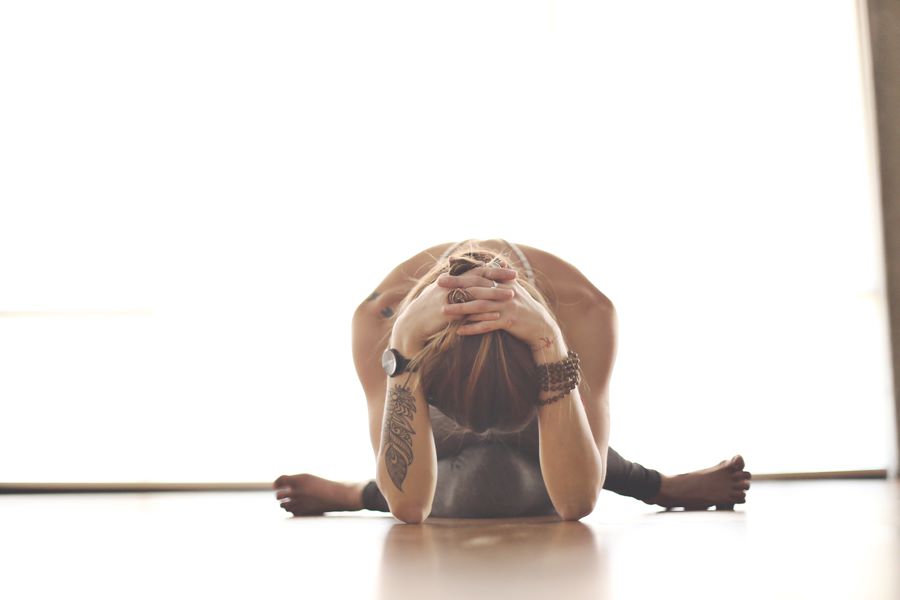
Seated Forward Bend Gomukhasana combines a hip opening with a forward bend. Begin by sitting on the floor and crossing one leg over the other, with the foot resting beside your opposite hip.
Reach your arms behind you and clasp your hands, or use a strap for support. Hinge at your hips, lengthening your spine as you fold forward. Breathe deeply and hold for several breaths.
2. Supta Gomukhasana
Supta Gomukhasana stretches your hips and hamstrings. Lie on your back and cross one leg over the other. Reach for your shin or foot of the top leg, whichever is comfortable. Gently lengthen your spine and hold for several breaths. Repeat on the other side.
3. Ardha Gomukhasana
Ardha Gomukhasana loosens your hips and shoulders. Begin by sitting on the floor with your legs extended. Inhale, then bend your right knee and place your right foot on top of your left thigh.
Keep your spine tall and chest lifted as you reach for your back with both arms. Clasp your hands behind your back if possible, or use a strap for assistance. Hold for a few breaths, then repeat on the other side.
Things to Know Before Doing Gomukhasana Yoga
Before beginning your Gomukhasana practice, several important aspects must be considered to ensure a safe and effective session. Proper preparation can help maximise the pose's benefits and avoid potential discomfort or injuries.
- Preparing the Muscles: Before attempting Gomukhasana, it’s crucial to warm up the body to prevent injuries. Gentle stretches and movements targeting the shoulders, hips, and spine help prepare the muscles and joints for the deeper stretch.
- Listening to Your Body: It's important to recognise and respect your body’s limitations. Do not force your body into the full pose if you experience pain or discomfort. Using modifications and props can help you gradually ease into the posture.
- Enhancing Comfort and Accessibility: Props such as yoga blocks, or bolsters can provide support and make Gomukhasana more accessible. For instance, a strap can help connect the hands behind the back if shoulder flexibility is limited.
- Ensuring Proper Form: Proper alignment is key to reaping the benefits of Gomukhasana and avoiding injury. Ensure that your spine is straight, your shoulders are relaxed, and your knees are stacked.
- Maintaining a Steady Breath: Focus on maintaining steady, deep breaths while in the pose. Proper breathing helps relax the muscles, deepen the stretch, and enhance the meditative aspect of the practice.
How Long to Sit in Gomukhasana?
The duration you should sit in Gomukhasana can vary depending on your comfort.
- Beginners: Beginners may start withholding Gomukhasana for about 30 seconds to 1 minute on each side. Focus on maintaining proper alignment and breathing steadily. Gradually increase the duration as comfort and flexibility improve.
- Intermediate Practitioners: Intermediate practitioners can aim to hold Gomukhasana for 1 to 2 minutes on each side. Pay attention to the breath and sensations in the body while holding the pose.
- Advanced Practitioners: Advanced yogis with greater flexibility and experience may hold Gomukhasana for 2 to 3 minutes or longer on each side. Listen to your body and adjust the duration accordingly to avoid overexertion.
Gradually increase the duration over time as flexibility and comfort in the pose improve. Consistent practice is key to experiencing the full benefits of Gomukhasana. Aim for balance by holding the pose for an equal duration on both sides to maintain symmetry in the body.
Risks of Overdoing Gomukhasana
While Gomukhasana offers numerous benefits when practised mindfully, overdoing or pushing too hard in the pose can lead to potential risks and discomfort. Here are some risks associated with overdoing Gomukhasana:
- Shoulder Strain and Injury: Overstretching or forcing the arms into the clasped position behind the back can strain the shoulders, leading to discomfort or even injury. This may manifest as shoulder pain, impingement, or rotator cuff issues.
- Hip Strain or Injury: Forcing the knees into a deep crossing position without adequate flexibility. This can lead to hip pain, and inflammation, or even exacerbate existing hip conditions like bursitis or tendonitis.
- Spinal Compression: Excessive rounding or collapsing of the spine while in Gomukhasana can compress the vertebrae and discs, leading to discomfort or exacerbating existing spinal issues such as herniated discs or spinal stenosis.
- Knee Discomfort: Forcing the knees into the stacked position without proper alignment, potentially leading to discomfort, inflammation, or aggravation of knee conditions such as meniscus tears or patellofemoral pain syndrome.
- Nerve Compression: Incorrect alignment or excessive pressure on the arms, legs, or spine in Gomukhasana can compress nerves, leading to numbness, tingling, or nerve irritation in the arms, legs, or spine.
- Increased Stress on Connective Tissues: Overstretching or pushing beyond one's limits in Gomukhasana can place excessive stress on connective tissues such as ligaments and tendons, increasing the risk of strain, and microtears.
It's essential to practise Gomukhasana mindfully, respecting your body's limitations, and avoiding the urge to push beyond what feels comfortable. Gradually progress in the pose, listen to your body's signals, and consult with a qualified yoga instructor if you experience any pain or discomfort.
Important Tips for Practising Gomukhasana
Like any other yoga pose, Gomukhasana involves a few considerations that must be made before performing it. Here are some pointers for performing the Gomukhasana steps properly and maximise your benefits:
Beginners may initially find Gomukhasana challenging, particularly placing their legs evenly on the floor. In turn, this makes it challenging to stack legs. To elevate and support your bones, use a blanket.
The ideal time to perform Gomukhasana is in the early morning. This is the time when your mind is clear, and your stomach and bowels are empty.
To prevent injuries, never begin practising Gomukhasanas before learning the right techniques from a qualified instructor. You can find this information on health apps or at yoga sessions nearby.
When beginning Gomukhasana, anyone with stiff shoulders or those who are overweight should hold off on clasping their hands behind their back.
If your hands don't lock together in the cow face position, you can use a strap behind your back to keep them together.
Between the Gomukhasana steps, never rush. Instead, to reap the most rewards, practise gently and comfortably.
To prevent exhaustion and injury, perform a warm-up before practising Gomukhasana and a cool-down afterwards.
The use of breath is crucial when performing Gomukhasana. Therefore, to fully benefit, make sure you are conscious of your breathing.
Avoid performing Gomukhasana if you have a fever, the flu, or a cold.
Avoid performing this asana if you are agitated or anxious to prevent your body from being fatigued.
Avoid performing Gomukhasana in a confined area. The area where you do this asana should be tidy and clutter-free. Additionally, it should have good ventilation and be quiet.
What are the Precautions and Contraindications of Gomukhasana?
Following are several occasions where practising the cow face pose may not be beneficial.
- Injury and Surgery: Individuals who have had surgery on their internal organs or have recently sustained a knee, hip, hamstring, quadriceps, neck, or shoulder injury should not engage in this activity.
- Physical Strength and Weakness: It is typically hardest to open the lower body while seated in the outside upper thighs. In order to do revolved Gomukhasana, individuals with tight hips and lower back problems should sit on a pillow or blanket to support their hips.
The practice of the cow face pose expands and activates the body's different meridians and the upper thighs' deeper tissues and ligaments. Additionally, in this position, the pelvic floor muscles are stressed, and the flow of blood to the pelvis is constrained.
Who Should Avoid Doing Gomukhasana?
While Gomukhasana offers numerous benefits, certain individuals should approach this pose with caution or avoid it altogether. Here are some groups of people who may need to avoid practising Gomukhasana:
- Shoulder Injuries: Individuals with current or past shoulder injuries, such as rotator cuff tears, shoulder impingement, or frozen shoulder, should avoid Gomukhasana, as it may exacerbate shoulder pain or discomfort.
- Hip Issues: Those with hip conditions like hip bursitis, hip labral tears, or severe hip osteoarthritis should avoid Gomukhasana, as the pose can place stress on the hip joints and exacerbate existing issues.
- Knee Problems: Individuals with acute knee injuries, chronic knee pain, or knee instability should approach Gomukhasana with caution or avoid it altogether, as the pose involves deep knee flexion and may aggravate knee discomfort.
- Spinal Conditions: People with spinal issues such as herniated discs, spinal stenosis, or severe scoliosis should avoid Gomukhasana, as the pose can potentially exacerbate spinal compression or discomfort.
- Pregnancy: Pregnant individuals, especially those in the second and third trimesters, should avoid Gomukhasana, as the deep hip and knee flexion may be uncomfortable or challenging.
- High Blood Pressure: Individuals with uncontrolled high blood pressure should avoid holding Gomukhasana for extended periods, as the pose may increase blood pressure levels due to the compression of blood vessels.
- Recent Surgery: People who have recently undergone shoulder, hip, knee, or spinal surgery should avoid Gomukhasana until they have fully recovered and received clearance from their healthcare provider.
- Beginners with Limited Flexibility: Beginners with limited shoulder, hip, or knee flexibility should approach Gomukhasana with caution and may benefit from modifications or preparatory poses to gradually build flexibility before attempting the full pose.
It's essential to listen to your body and consult with a qualified yoga instructor or healthcare provider if you have any concerns or underlying health conditions before attempting Gomukhasana or any other yoga poses.
What are the Easy Modifications of Gomukhasana?
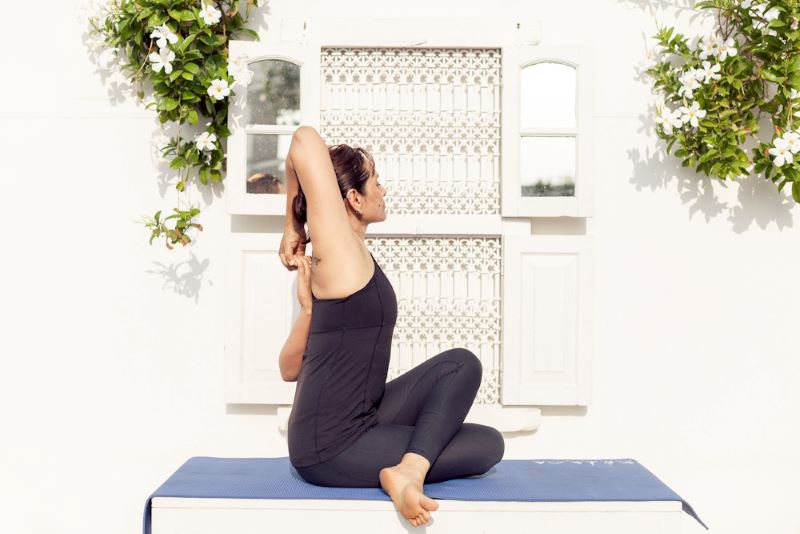
Gomukhasana might be difficult for individuals to master at first, So let's find alternate approaches or adjust this position to make it a little more straightforward and uncomplicated. Some of them are as stated.
Less strain will be placed on the hips and lower back if a decent blanket is used below the buttocks.
Using a block and seating on it will assist in bringing the knees near to the floor, allowing for easier thigh overlapping.
Yoga straps or elastic bands can be used between your hands if your elbows are not strong and flexible enough to allow your palms to interlock.
Alignment is necessary when performing the Cow Face Pose since balancing the body's two sides is crucial. Gomukhasana is one pose that can help to enhance this balance. Working on the body's weaker side is essential to achieve equilibrium between the two sides.
While attempting to hold your palms together behind you, your head shouldn't drop. Ensure your chin is up and in line with your collarbone and chest.
Folding one leg at a time without overlapping the thighs can be done slowly. Start the exercise by folding only one leg and one elbow, then progress to the full stance after many repetitions.
So, now that you know the benefits of Gomukhasana, it is clear that practising it with the help of an instructor can improve your mental and physical health. In addition, individuals should remember that a better body posture would boost their confidence. It also increases their productivity and reduces the risk of injuries.













